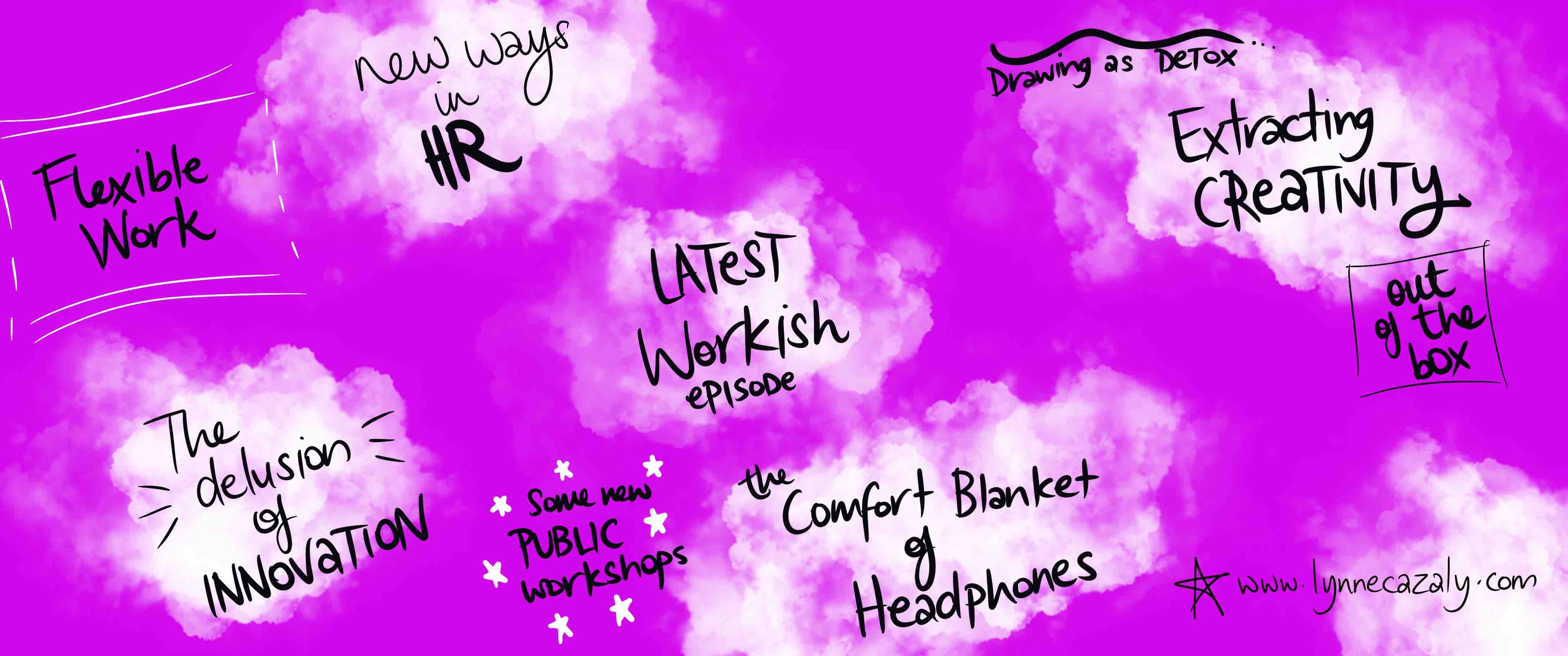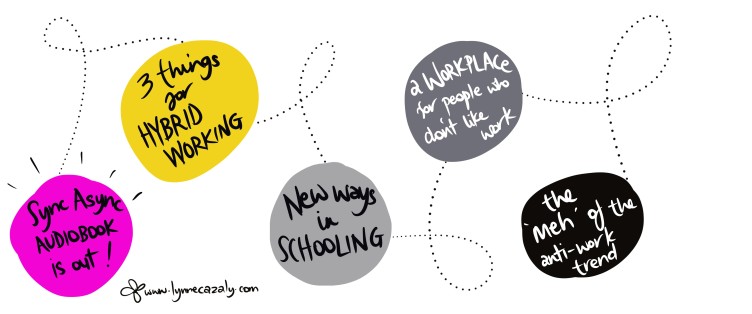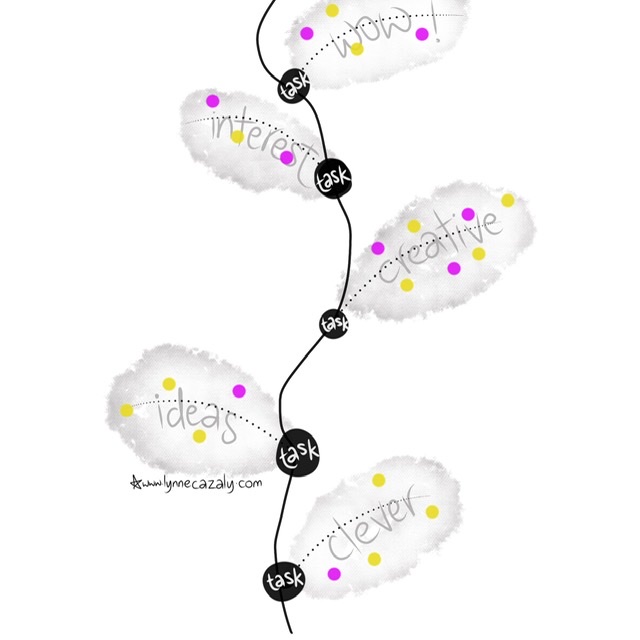Innovation delusions/flexible work/new ways in HR/headphone buzz/creative thinking/drawing detox
 Wednesday, August 23, 2023 at 10:20AM
Wednesday, August 23, 2023 at 10:20AM For HR : new-ish ways of working
For HR people, teams, leaders, practitioners:
It might be a little agile, a little NWOW, a bit of this and a bit of that - all designed to suit the team, who they are, how they work and what they need to achieve.
I've worked intensely with several HR teams over the past year, building their awareness, capabilities and behaviours to work in new-ish ways.
Get in contact if you're an HR professional, part of an HR team or are curious about how New Ways in HR can help.
Out of the box... but not too far
What organisation doesn't want their people, teams and leaders to be innovative and creative?
Yet when they do, or try to be, it can become 'too far' out of the box.
The thinking, ideas and suggestions can seem
- too radical
- too extreme
- too costly
- too time consuming
- too big a change or
- require too much time and effort.
The 'too much' ... not that far, WOAH, we didn't mean THAT creative or innovative -- is prevalent in many teams and organisations.
It's a kind of 'we want your creativity but keep it in control, please.'
And we may rush to criticise this response, but remember that brilliant creativity IS possible within a box, boundary or constraint.
It's how many artists and innovators create such clever thinking and ideas; via a restriction or limitation - in time, resources, space, materials, thought or imagination.
So yes, think out of the box, but it your thinking and ideas ARE a bit too far out there and it's too much for a leader, team or organisation to acknowledge, validate, support or endorse ... it's ok.
Re-check the brief, the boundaries and the constraints. Superb creativity and ideation is still possible in a slightly more controlled situation.
The key for leaders is they must specify or explain the boundaries. And if they haven't, ask 'em!
Then you can go WILD creating within that scope.
Give me some boundaries any day and I'll create with wild fervour! Say there are no boundaries, that anything is possible - or omit to explain the scope - and I may be hesitant in case I push it too far.
Even if you think you're not that creative, or that the organisation doesn't think far enough out of the box it is in, check the scope and boundaries that exist and then go wild.
Push to the absolute edges and extremes of the boundaries.
The delusion of innovation in the office
The debate to return to the office has escalated for some employees - and turned into a mandate or stronger for some.
A number of reasons to return are presented by businesses, but it’s this one — better collaboration and innovation — that I’d like to explore.
Because nothing has changed.
Requiring people to come to a specific geography infers there might be better or greater collaboration and innovation happening there. But nothing has changed.
Since the pandemic and the forced remote era, have businesses and their leaders set new processes, conditions, constraints, capabilities, situations or environments for making all this magical collaboration and innovation happen?
Yeah? No.
A call to return to the office because it will ‘be more collaborative and innovative’ has seen employees in quiet offices and meeting rooms in online meetings trying to do all the innovation and stuff.
But nothing in the environment has changed to boost, invite or foster it. It’s the same old tired grey meh.
Collaboration and innovation relies on a process or constraint, a purpose or a reason to get it going and make it happen.
Some teams are great at it, having forged a collaborative, communicative and creative culture of working together like this for some time. No matter the geography and whether they’re together or apart, in person or remote.
But if nothing has changed about how leaders are setting up the conditions and situations for collaboration and innovation … it won’t … just … happen.
If nothing much has changed in how a business facilitates, guides or supports collaboration and innovation, arriving into a same-old stale office situation will do nothing to make people magically start collaborating and innovating.
It will do the reverse and make ideas and energy evaporate.
Collaborations and innovation seem like great reasons to spend more time in person with colleagues in a workplace.
But if nothing has changed in how leaders lead collaboration and innovation … it’s just … not … happening.
New ways of working need new ways of leading - not mandates and force.
The latest Workish episodes
Workish #4 with Lynne Cazaly
This episode features: What's behind the fear toward AI; What might be greater than wellbeing at work; The new fusion of 3 things in the workplace; Solving the challenges of learning; Boosting your diversity, equity and inclusion understanding ... and, some Randomness
Workish #5 with Lynne Cazaly
Do you have a toxic culture of niceness /How to stop the 'where are you working from today' questions / How to keep in touch with the office buzz ... and one thing that could be killing it / How you could be missing out on coaching, development or feedback / A cool choice for increasing employee retention and flexibility
Extracting creativity from reality
You know those reality shows on cooking, baking and making — you can love ‘em or hate ‘em — but there’s so much to learn from them.
And it’s not how to make a buttercream something or be a crowd favourite!
Each episode centres on a themed challenge. Plus it’s time-based as well, to help build the pressure, performance and interest.
Look beyond the characters or the game and you’ll see so many brilliant skills and capabilities at work.
Skills and techniques like:
🌀Listening - to a story, brief, background or feedback
🌀Understanding - the situation, challenge or problem to solve
🌀Ideation - of options, answers and making elements for the task
🌀Imagination - to find alternate methods or techniques
🌀Problem solving - when you’re bringing your idea from a conjured mental image to reality
🌀Slicing - not just the cake but breaking the seemingly insurmountable task into smaller steps
🌀Emotional regulation - dealing with anticipation, disappointment, nerves, doubt or dashed expectations
🌀Crisis management - when something unexpected happens, fails or breaks
🌀Persistence when a task seems impossible within the constraints
🌀Scaling - for quantity or visual impact
🌀Optimism - in the face of wanting to give up or run away.
We may not be certain what a particular skill or capability looks like until we see it demonstrated. These creative programs are packed full of skillful flavour … skills that apply to work and life.
Watch how people think, understand and act in an environment that demands changing and adaptive innovation.
What skills have you seen people display to solve the challenge and make the thing?
📺 What to watch?
Check Netflix and see programs like ‘Is it cake?’ or ‘Bake Squad’.
The comfort blanket of headphones 🎧
Do you use them, you know, really need them — headphones — for silence, concentration and focus?
Or as described here, are they ‘a way of insulating oneself against the hell that is other people’.
From the bustle and buzz of the pre pandemic workplace to the isolation of remote work: the silence and quiet of just a lone voice or three at home has potentially given us a greater need for the comfort of quiet.
All the noise cancelling time.
I wore them walking around a shopping centre the other day to create my own ambience and vibe thank you very much.
Boarding a plane and we may don the ear blanket asap. Or pre boarding if you really want protection from all the peoples that will be squashed together inside the metal.
Zoning out from others’ podcasts or streaming choices? Pass me my comforter… I mean my AirPods.
Debates aplenty here with:
▫️ear damage and etiquette
versus
▫️focus and creativity.
What say you? Hey… you, *waving*, talk to me will you.
What do you think about headphones at work, in life, in sleep, in a shop, at home? Do you need … you know, really neeeed?
Drawing is the best digital detox
Read more about how and why to detox and why drawing, sketching, getting into something a little less bright-light, might be just what you need
Designing for flexible work
Some brilliant insights in an article on flexibility for workers — not just parents who might want time off during the week, but older workers who might want a chunk of time off to travel.
And this often overlooked benefit :
“By sharing their knowledge, skills and life experiences, our older team members often become great mentors to their younger teammates.”
With life, industry and trade experience older workers are valuable to the team … and customers.
Flexible recruitment processes, flexible rostering and a reduction in hours when on the path to retirement, are all smart benefits that demonstrate a broader understanding of what it means to be flexible.
Read more here from The Sydney Morning Herald and The Age





















